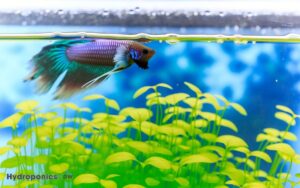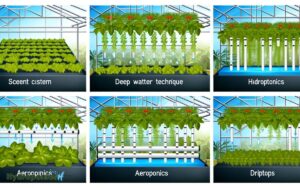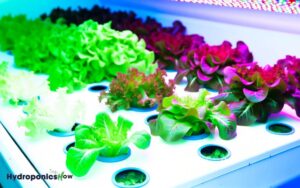10 Best Types of Hydroponic Systems for Growing Cabbage
Cabbage achieves peak growth in hydroponic systems such as Deep Water Culture (DWC) and Nutrient Film Technique (NFT).
DWC guarantees effective oxygenation and nutrient delivery, fostering accelerated growth and high yields.
NFT provides a continuous flow of nutrients, which enhances root oxygenation and nutrient uptake efficiency, leading to improved quality and productivity.
While other systems like Ebb and Flow, Drip, and Wick also support cabbage cultivation, DWC and NFT deliver the most consistent results for robust cabbage growth.
These systems promote ideal conditions for nutrient absorption, root health, and disease resistance, essential for commercial and home hydroponic setups. To learn more, consider additional factors of specific system efficiencies. Proper lighting, temperature control, and oxygenation further enhance plant growth, ensuring maximum yield and quality. When selecting the best hydroponic systems for spinach, factors such as water circulation, nutrient delivery, and space efficiency play crucial roles. By optimizing these elements, growers can achieve consistent and healthy spinach production year-round.

Key Takeaways
Deep Water Culture
Deep Water Culture (DWC) is a hydroponic technique where cabbage roots are submerged directly in a nutrient-rich, oxygenated water solution. This system involves suspending cabbage plants above a reservoir, allowing roots to extend into the solution.
DWC systems use air pumps to deliver dissolved oxygen, essential for root respiration and nutrient absorption. Research indicates that DWC can accelerate cabbage growth due to constant nutrient availability and ideal oxygen levels.
This method minimizes water use compared to soil cultivation and reduces the risk of soil-borne diseases. However, maintaining stable temperatures and pH levels is vital for excellent outcomes.
Evidence shows that DWC can achieve higher yields and faster growth rates, making it a viable option for commercial hydroponic cabbage production.
Nutrient Film Technique
The Nutrient Film Technique (NFT) provides a continuous nutrient flow, resulting in cabbage plants receiving a consistent supply of essential minerals.
This method enhances root oxygenation by allowing the roots to be exposed to air, thereby preventing hypoxic conditions and promoting robust plant growth.
Evidence suggests that NFT systems can optimize nutrient uptake efficiency, leading to improved yield and quality in hydroponically grown cabbage.
Continuous Nutrient Flow
Employing the Nutrient Film Technique (NFT) in hydroponic systems involves a shallow stream of nutrient-rich water circulating continuously over the roots of cabbage plants, ensuring optimal nutrient absorption and oxygenation.
This method is particularly effective due to several key advantages:
- Consistent Nutrient Delivery: Guarantees plants receive a steady supply of essential nutrients.
- Efficient Water Use: Reduces water wastage by recirculating the nutrient solution.
- Enhanced Growth Rates: Promotes faster growth compared to traditional soil methods.
- Reduced Root Disease: Minimizes the risk of root pathogens due to improved oxygenation.
- Scalability: Easily adaptable for both small-scale and large-scale operations.
These benefits make NFT a preferred choice for cultivating robust and healthy cabbage in hydroponic systems.
Root Oxygenation Benefits
Enhancing root oxygenation through the Nutrient Film Technique (NFT) greatly improves cabbage plant health by increasing nutrient uptake and metabolic efficiency.
NFT systems maintain a thin film of nutrient solution flowing over the roots, which optimizes oxygen availability and facilitates rapid gas exchange. This continuous aeration reduces the risk of root zone hypoxia, a condition detrimental to plant growth.
Studies show that improved root oxygenation leads to enhanced nutrient absorption, promoting robust vegetative growth and higher yield potential. Additionally, the technique minimizes root diseases by preventing anaerobic conditions.
Therefore, NFT’s ability to deliver highly oxygenated nutrient solutions makes it a superior choice for maximizing cabbage crop productivity in hydroponic setups.
Ebb and Flow System
An Ebb and Flow system, also known as a flood and drain system, utilizes a cyclic process to temporarily flood the plant roots with nutrient-rich water before draining it back into a reservoir.
This method guarantees ideal nutrient uptake and root oxygenation, essential for cabbage growth. The intermittent flooding prevents root rot and facilitates robust plant development.
Key advantages of the Ebb and Flow system include:
- Efficient nutrient delivery: Nutrients are evenly distributed during each cycle.
- Improved oxygenation: Draining cycles allow roots to access oxygen, reducing anaerobic conditions.
- Scalability: Suitable for both small and large-scale operations.
- Cost-effective: Minimal energy requirements compared to continuous flow systems.
- Versatility: Adaptable to various growing media and plant types, including cabbage.
These benefits make the Ebb and Flow system particularly effective for hydroponically growing cabbage.
Wick System
Contrasting the dynamic nature of the Ebb and Flow system, the Wick system employs a passive approach to nutrient delivery, relying on capillary action to transport nutrient solution from a reservoir to the plant roots via wicking materials.
This method is inherently simple and requires minimal mechanical intervention, making it ideal for small-scale cabbage cultivation. However, its efficacy is contingent on the choice of wicking material and the nutrient absorption rate.
The table below delineates key parameters:
| Parameter | Efficacy for Cabbage | Notes |
|---|---|---|
| Nutrient Delivery | Moderate | Suitable for small-scale operations |
| Maintenance | Low | Minimal mechanical parts required |
| Cost | Low | Economical startup cost |
| Growth Rate | Moderate | Slower compared to active systems |
| Scalability | Limited | Best for personal or small gardens |
This system promotes steady, albeit modest, growth of cabbage.
Drip System
Why does the Drip System stand out as a superior hydroponic method for cabbage cultivation?
The Drip System offers precise control over nutrient delivery, guaranteeing ideal growth conditions for cabbage. This method allows for personalized nutrient and water management, reducing the risk of overwatering or nutrient imbalances.
Key advantages include:
- Uniform Nutrient Distribution: Ensures each plant receives consistent nutrient levels.
- Water Efficiency: Drip emitters minimize water wastage.
- Scalability: Easily adaptable for various garden sizes and commercial operations.
- Reduced Disease Risk: Minimizes standing water, lowering the risk of root diseases.
- Cost-Effective Maintenance: Simple to set up and maintain compared to more complex systems.
Studies indicate that the Drip System’s controlled environment significantly enhances cabbage yield and quality.
Aeroponics
Aeroponics represents an advanced hydroponic technique in which nutrient solutions are atomized and sprayed directly onto the roots, ensuring efficient nutrient delivery. This method greatly enhances root oxygenation, a critical factor for optimizing plant metabolic processes.
Empirical studies have demonstrated that aeroponics can substantially accelerate growth rates in cabbage, resulting in higher yields and superior plant health.
Efficient Nutrient Delivery
Utilizing high-pressure mist to deliver nutrient solutions directly to the roots, aeroponics represents an advanced and efficient method for nutrient delivery in hydroponic systems tailored for cabbage cultivation.
This high-efficiency system guarantees superior nutrient absorption and promotes vigorous growth.
Key advantages include:
- Maximized Nutrient Uptake: Direct root exposure allows for excellent nutrient assimilation.
- Reduced Water Usage: Aeroponics uses much less water compared to other hydroponic systems.
- Faster Growth Rates: Enhanced nutrient delivery speeds up growth cycles.
- Precision Control: Allows for precise adjustment of nutrient concentrations.
- Reduced Disease Risk: Minimal water logging decreases vulnerability to root diseases.
Evidence suggests aeroponics significantly boosts cabbage yield and quality, making it a viable option for efficient, sustainable agriculture.
Root Oxygenation Benefits
Moreover, aeroponics confers significant benefits through enhanced root oxygenation, which is critical for optimizing cabbage plant health and productivity.
Increased oxygenation at the root zone facilitates superior cellular respiration, which is essential for energy production and metabolic processes.
Research indicates that roots exposed to higher oxygen levels exhibit improved nutrient uptake efficiency and enhanced resistance to pathogens.
This heightened oxygen availability fosters robust root development, leading to stronger, healthier plants.
Moreover, aeroponic systems employ intermittent misting, ensuring roots are consistently supplied with dissolved oxygen, preventing hypoxic conditions that could impede growth.
Consequently, aeroponics provides a compelling advantage in cultivating cabbage by promoting vigorous root health and maximizing overall plant performance.
Growth Rate Enhancement
Empirical evidence demonstrates that aeroponic systems can greatly accelerate the growth rates of cabbage plants compared to traditional soil-based cultivation methods.
This is attributed to the optimized delivery of nutrients and oxygen directly to the root zone, fostering enhanced metabolic activities.
Aeroponic systems facilitate precise control over environmental conditions, resulting in more consistent and rapid growth cycles.
Key advantages of aeroponics include:
- Enhanced nutrient uptake efficiency
- Increased root oxygenation, promoting robust root development
- Reduced incidence of soil-borne diseases
- Efficient water usage, reducing overall consumption
- Accelerated growth rates, leading to quicker harvests
These factors collectively contribute to maximizing the yield potential of cabbage crops, making aeroponics an ideal choice for high-density, high-efficiency agricultural practices.
Vertical Hydroponics
Vertical hydroponics offers an efficient method for cultivating cabbage through the strategic use of vertically stacked growing systems that maximize space utilization and enhance nutrient delivery.
This system employs a tiered structure where each level supports individual plants, optimizing spatial efficiency particularly in urban or constrained environments.
Enhanced nutrient delivery is achieved through nutrient film techniques or aeroponics, ensuring uniform distribution and uptake. Studies indicate an increase in yield per square meter compared to traditional horizontal systems.
Additionally, vertical hydroponics facilitates controlled environments, reducing pest exposure and promoting consistent growth conditions.
This method aligns with sustainable agricultural practices by minimizing water usage and enabling year-round production, making it an ideal choice for maximizing cabbage growth efficiency.
Aquaponics
Integrating aquaponics into cabbage cultivation leverages the symbiotic relationship between fish and plants. Nutrient-rich fish waste provides a sustainable and efficient nutrient source for hydroponically grown cabbage.
This approach not only enhances nutrient uptake but also promotes healthier and faster growth.
Key advantages include:
- Sustainability: Minimizes chemical fertilizer use, leveraging natural fish waste.
- Efficiency: Continuous nutrient supply guarantees ideal plant health.
- Water Conservation: Closed-loop system reduces water consumption compared to soil-based agriculture.
- Reduced Waste: Converts fish waste into valuable plant nutrients, minimizing environmental impact.
- Synergy: Enhances overall system productivity with dual output of fish and cabbage.
Evidence indicates that aquaponics can achieve similar or superior yields compared to traditional hydroponic systems, making it a viable method for sustainable cabbage cultivation.
Kratky Method
The Kratky Method represents a passive growth technique that eliminates the need for active water circulation, relying instead on a static nutrient solution reservoir.
This low-maintenance approach reduces both the frequency and complexity of system monitoring, making it an efficient option for cultivating cabbage.
Evidence suggests that when properly managed, the Kratky Method can achieve comparable yield outcomes to more complex hydroponic systems, while minimizing operational inputs.
Passive Growth Technique
Utilizing the Kratky Method, a passive hydroponic technique, allows for efficient water and nutrient delivery to cabbage plants without the need for pumps or electricity. This method relies on a static water reservoir, where the roots of cabbage plants receive nutrients directly.
Key advantages of the Kratky Method include:
- Simplicity: Requires minimal setup and maintenance.
- Cost-Effectiveness: Eliminates the need for mechanical components.
- Energy Efficiency: Operates without electricity.
- Water Conservation: Reduces water usage compared to traditional methods.
- Scalability: Easily adaptable for both small and large-scale operations.
Research indicates that cabbage grown using the Kratky Method exhibits robust root development and consistent nutrient uptake, making it a viable solution for hydroponic agriculture.
Maintenance and Monitoring
Effective maintenance and monitoring in the Kratky Method involve regularly checking water levels, pH balance, and nutrient concentration to guarantee ideal growth conditions for cabbage plants.
Monitoring water levels ensures that the roots have sufficient access to nutrients and oxygen, preventing wilting or stunted growth.
pH balance should be maintained between 5.5 and 6.5 to optimize nutrient uptake, as deviations can lead to nutrient lockout.
Nutrient concentration, measured in parts per million (ppm), should be adjusted based on the cabbage growth stage, with recommended levels between 1,000 and 1,500 ppm.
Regularly inspecting for algae growth or root rot is essential, as these issues can impair plant health.
Utilizing precise instruments for these measurements enhances accuracy and promotes robust cabbage cultivation.
Dutch Bucket System
In hydroponic cultivation, the Dutch Bucket System serves as an efficient method for growing cabbage. It leverages individual containers to guarantee ideal nutrient delivery and water management.
This system utilizes interconnected buckets, each equipped with a drain to recirculate nutrient solutions.
The Dutch Bucket System is particularly advantageous for cabbage due to its ability to support large root systems and manage frequent watering cycles.
Key benefits include:
- Consistent nutrient availability: Each bucket receives a perfect mix of nutrients.
- Efficient water use: Recirculating system minimizes waste.
- Scalability: Easily expandable by adding more buckets.
- Root aeration: Improved oxygenation promotes healthier roots.
- Pest and disease management: Isolated containers reduce cross-contamination.
This system’s design guarantees robust growth by maintaining precise control over the growing environment.
Comparison of Systems
While the Dutch Bucket System showcases distinct advantages for hydroponic cabbage cultivation, it is imperative to evaluate its performance relative to other hydroponic systems to determine the most efficient approach.
Comparative analysis reveals that different systems offer unique benefits and limitations based on factors such as water usage, space efficiency, and plant health.
The table below delineates these attributes in detail.
| System | Key Attributes |
|---|---|
| Dutch Bucket System | Excellent for larger plants, scalable |
| Nutrient Film Technique | Efficient water use, risk of root rot |
| Deep Water Culture | High growth rate, oxygenation required |
| Aeroponics | Maximal nutrient absorption, complex |
This critical evaluation underscores the necessity for tailored choices in hydroponic systems, ensuring ideal growth conditions for cabbage.
Nutrient Management
Essential nutrient management is essential in hydroponic cabbage cultivation, ensuring that plants receive a balanced supply of essential macro and micronutrients to promote robust growth and maximize yield.
Key nutrients include nitrogen, phosphorus, potassium, calcium, magnesium, and trace elements such as iron, manganese, zinc, and copper.
Ideal nutrient solutions should be carefully formulated and monitored to maintain pH levels between 5.5 and 6.5, ensuring nutrient availability and uptake.
- Nitrogen (N): Critical for leaf development and chlorophyll synthesis.
- Phosphorus (P): Supports root growth and energy transfer processes.
- Potassium (K): Enhances overall plant health and disease resistance.
- Calcium (Ca): Essential for cell wall integrity and growth.
- Magnesium (Mg): Vital for chlorophyll production and enzyme activation.
Regular monitoring and adjustment of nutrient solution concentrations are imperative for excellent cabbage growth in hydroponic systems.
Light Requirements
Sufficient light intensity and duration are essential for maximizing photosynthesis and ensuring healthy growth in hydroponic cabbage cultivation. Light-emitting diode (LED) systems are highly recommended due to their energy efficiency, spectral customization, and longevity.
Cabbage requires a light intensity of approximately 400-600 µmol/m²/s and a photoperiod of 14-16 hours per day to enhance growth rates and head formation.
Research indicates that wavelengths in the blue (450-495 nm) and red (620-750 nm) spectra are particularly effective in driving photosynthetic activity.
Controlled environment studies have demonstrated that inadequate light can lead to leggy, underdeveloped plants, while excessive light may cause leaf burn and photoinhibition.
Therefore, precise control of light parameters is crucial for successful hydroponic cabbage production.
Conclusion
In the domain of hydroponic cultivation, cabbage finds its most harmonious growth in systems where nutrient delivery mirrors the steady, unyielding flow of a river.
Deep Water Culture and Nutrient Film Technique stand as pillars of efficiency, ensuring continuous nourishment.
Ebb and Flow, Wick, Drip, and Dutch Bucket Systems offer varied yet effective support. The symphony of nutrient management and light requirements orchestrates an environment where cabbage can flourish, echoing the precision and balance of a well-tuned instrument.






